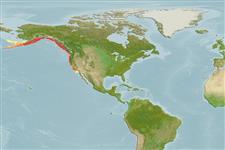>
Perciformes/Scorpaenoidei (Scorpionfishes) >
Sebastidae (Rockfishes, rockcods and thornyheads) > Sebastinae
Etymology: Sebastes: Greek, sebastes = august, venerable (Ref. 45335); entomelas: Species name from the Greek ento and melas, meaning 'within' and 'black' (Ref. 27436).
More on authors: Jordan & Gilbert.
Environment: milieu / climate zone / depth range / distribution range
Écologie
marin; profondeur 0 - 549 m (Ref. 27437). Temperate; 60°N - 32°N
Northeast Pacific: middle Albatross Bank in the Gulf of Alaska to Todos Santos Bay, Baja California, Mexico.
Length at first maturity / Taille / Poids / Âge
Maturity: Lm 36.0, range 29 - ? cm
Max length : 60.0 cm TL mâle / non sexé; (Ref. 9015); âge max. reporté: 60 années (Ref. 39247)
Description synthétique
Clés d'identification | Morphologie | Morphométrie
Épines dorsales (Total) : 13; Rayons mous dorsaux (Total) : 14 - 16; Épines anales: 3; Rayons mous anaux: 8 - 10. Head spines weak - nasal, preocular spines present, parietals usually present, supraocular, postocular and tympanic spines usually absent, coronal and nuchal spines absent (Ref. 27437). Interorbital space convex, sloped; no symphyseal knob; caudal peduncle narrow; anal fin with a strong posterior slant (Ref. 27437). Caudal fin indented (Ref. 6885). Gold brown to dusky, light ventrally; membranes of fins dark, lighter on spinous dorsal (Ref. 27437).
A generally active and free-swimming rockfish found in midwater above a rocky reef or steep shoreline; occasionally huddling motionless among caves and crevices (Ref. 27436). Young are found in shallow water (Ref. 2850). Form schools (Ref. 2850). Feed mostly on small pelagic crustaceans and fishes (Ref. 2850). Viviparous (Ref. 34817). Marketed fresh and frozen; eaten pan-fried, boiled, microwaved and baked (Ref. 9988).
Eschmeyer, W.N., E.S. Herald and H. Hammann, 1983. A field guide to Pacific coast fishes of North America. Boston (MA, USA): Houghton Mifflin Company. xii+336 p. (Ref. 2850)
Statut dans la liste rouge de l'IUCN (Ref. 130435)
Menace pour l'homme
Harmless
Utilisations par l'homme
Pêcheries: commercial; pêche sportive: oui; Aquarium: Aquariums publics
Outils
Articles particuliers
Télécharger en XML
Sources Internet
Estimates based on models
Preferred temperature (Ref.
123201): 3.4 - 8.6, mean 5.6 °C (based on 213 cells).
Phylogenetic diversity index (Ref.
82804): PD
50 = 0.5000 [Uniqueness, from 0.5 = low to 2.0 = high].
Bayesian length-weight: a=0.01000 (0.00499 - 0.02004), b=3.09 (2.92 - 3.26), in cm total length, based on LWR estimates for this Genus-body shape (Ref.
93245).
Niveau trophique (Ref.
69278): 3.7 ±0.3 se; based on diet studies.
Résilience (Ref.
120179): Très faible, temps minimum de doublement de population supérieur à 14 ans (tm=6; tmax=60; also Musick et al. 2000 (Ref.
36717)).
Prior r = 0.06, 95% CL = 0.04 - 0.09, Based on 1 full stock assessment.
Fishing Vulnerability (Ref.
59153): Moderate vulnerability (44 of 100).
Climate Vulnerability (Ref.
125649): Low to moderate vulnerability (35 of 100).
Nutrients (Ref.
124155): Calcium = 18.8 [8.2, 52.3] mg/100g; Iron = 0.271 [0.116, 0.604] mg/100g; Protein = 18.2 [17.0, 19.4] %; Omega3 = 1.33 [0.53, 3.32] g/100g; Selenium = 35.7 [14.5, 90.3] μg/100g; VitaminA = 24.4 [8.0, 73.0] μg/100g; Zinc = 0.394 [0.214, 0.705] mg/100g (wet weight);
